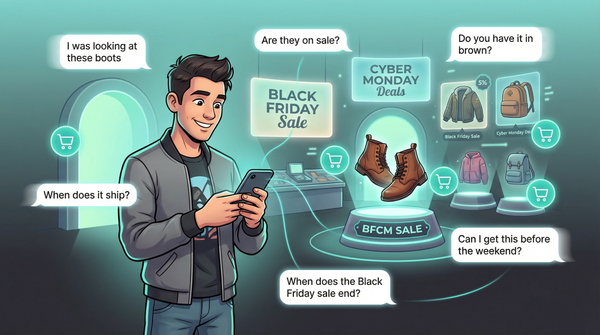Shopify Shakeout: Why Many DTC Stores Are Shuttering

More Shopify stores are closing than opening in mid-2025. That stat alone has rattled DTC circles—and the 20–25% YoY revenue dip for smaller brands in June only confirms what operators have felt all quarter: this isn’t just a summer slowdown, it’s a real shakeout .
“The dip in Shopify [growth] for the first time in a long time is painful.”
— Rishabh Jain via The DTC Times
After years of easy growth, cheap ads, and pandemic-fueled demand, a wave of unsustainable brands is folding. The DTC ecosystem is resetting—and the operators who adapt fastest will be the ones still standing in 2026.
Store Closures Now Outpace Launches
In Q2 2025, Shopify’s merchant churn quietly turned negative: 1.5 stores closed for every new one opened. (Stuart Chaney, X)
I've had over 2,000,000 Shopify Stores install at least one of my apps since 2015.
— Stuart Chaney (@stu_chaney) June 29, 2025
Here's some data showing the acceleration of closure rates in Shopify stores since 2021.
Q2 2025 shows that for every 1 install, we are seeing 1.5 stores close (shut down).
store closures /… pic.twitter.com/twLPZnBTwN
That’s a first.
Shopify still boasts over 5M stores globally , but its breakneck expansion has finally stalled. As ad costs rise and capital dries up, it’s no longer enough to just launch a product and run Facebook ads.
Many of the brands going dark this summer were built for a different environment—one where Meta CPAs were cheap and everyone was at home scrolling. That model doesn’t work in a world of flat consumer demand and expensive growth.
Not Just Seasonal—This Is a Structural Reset
Summer’s always slower, but this drop is different.
- Overall DTC revenue was down ~9% YoY in June
- Smaller Shopify brands saw 20–25% drops compared to 2024
- U.S. consumer confidence hit new lows in June
- 40% of households said their income is down YoY
Shoppers aren’t just sunbathing. They’re pulling back.
And the softening is showing up everywhere: Allbirds reported an 18% revenue decline in Q1, while beauty, apparel, and home categories are seeing flat-to-declining sales across the board .
“We expected a soft summer. Not like this.”
— DTC brand operator via DTC Live
Investor Taylor Holiday put it bluntly: this is a correction, not a blip .
What’s Causing the DTC Collapse?
Let’s break it down:
1. Paid Ads Are Bleeding Margins
Meta CPMs hit $12.74 in June. And ROAS is dropping even as spend climbs .
“If your only growth lever is Meta in 2025, your DTC brand is not going to make it.”
— Ron Shah, CEO of Obvi
If your only growth lever is Meta in 2025, your DTC brand is not going to make it.
— Ron Shah (@obviceo) July 2, 2025
Brands relying only on paid acquisition aren’t just playing on hard mode, they’re risking a death spiral.
Here’s how it happens:
Meta gets more expensive → you double down to “make it work” →…
Operators that didn’t diversify beyond Facebook are now boxed in. The returns just aren’t there—and those brands are the first to fold.
2. Post-COVID Demand Is Gone
Home goods, apparel, and beauty all spiked during the pandemic. Now? They’re saturated and stagnant .
Even premium DTC brands are getting humbled. And with consumers prioritizing travel and offline experiences, the TAM for many products is smaller than founders want to admit.
3. Tariffs + Costs = No Cushion
Steel and aluminum tariffs doubled in June. Chinese imports are still hit with 20–30% duties. And 3PL fees, payment processing, and shipping costs haven’t eased .
Margins are getting crushed. In April alone, 1% of Finaloop’s mostly mid-size Shopify clients filed for Chapter 11—a stat that matched all of 2024 .
4. Funding Is Frozen
VC money isn’t flowing like it used to. Brands that can’t show profitability—or a tight path to it—aren’t getting rescued anymore. That’s left many founders without a parachute in Q2 and Q3.
Who’s Getting Hit Hardest?
The categories falling fastest:
- Beauty & skincare: once booming, now viewed as non-essential
- Apparel: saturated and highly commoditized
- Home & furniture: hammered by tariffs + demand shift
- Supplements & basics: struggling to compete with Amazon
Meanwhile, brands in essentials (health, pet, grocery) or travel/outdoor gear are holding up better. Niche hobbies with community moats (cycling, crafts) also have more staying power.
What Operators Are Doing to Survive
Here’s how smart Shopify brands are adjusting in real time:
1. Retention Over Everything
New customers are expensive. Returning customers are profitable. Operators are investing in:
- SMS & email flows
- Loyalty programs
- Personalized post-purchase experiences
“If you can’t get them to come back, you are just a transaction machine.”
— Sean Frank, Ridge Wallet via DTC Live
Tools like LiveRecover also fit here—recovering abandoned checkouts via live human SMS, not just bots. In a world where every acquisition dollar counts, retaining high-intent traffic at checkout is a small move with a big ROI. Especially when it happens in real time—before they bounce forever.
2. Diversifying Channels & Revenue
The best operators aren’t stuck on Meta. They’re exploring:
- Influencer and affiliate campaigns
- TikTok organic + paid
- Retail and wholesale (yes, Target’s back on the map)
- Amazon and marketplace strategies
In Q1 2025, wholesale was actually up for DTC brands under $50M .
3. Cutting Fast, Scaling Smart
Every expense is under review. Operators are:
- Pausing underperforming SKUs
- Switching fulfillment partners
- Prioritizing margin over “growth”
This isn’t survival mode—it’s smart business building. Many founders are learning to love contribution margin for the first time.
4. Sharpening the Value Prop
Why should a cash-strapped customer buy from you—today?
Brands that can’t answer that are fading. Brands that can? They’re winning more than just clicks.
Survivors are doubling down on differentiation, pricing clarity, and product story. It’s back to basics, and it’s working.
This Is the Reset
Is this temporary? Yes.
Is it also permanent? Yes.
The Shopify shakeout of 2025 is real—but it’s also necessary. The DTC ecosystem was bloated with me-too products and ad-fueled hype. Now, it’s being forced to mature.
“Compression creates clarity.”
— Operator via DTC Live
The brands that survive this year won’t just be more resilient. They’ll be more profitable, focused, and customer-led. And that’s a win—for the whole ecosystem.
Subscribe for weekly DTC insights.




